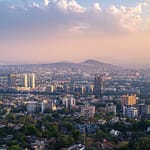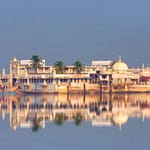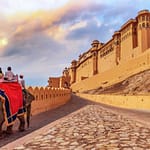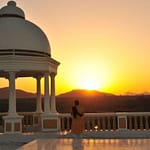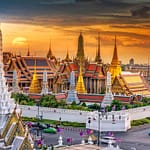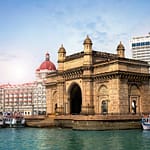Bihar, a state in India, boasts a rich cultural heritage and a diverse array of tourist attractions. From the sacred city of Bodh Gaya, where Gautama Buddha attained enlightenment, to the ancient university town of Nalanda, there’s something for every kind of traveler. Visitors can explore the spiritual depth of Gaya, the historical treasures of Patna, and the natural beauty of the Valmiki Tiger Reserve.

Bihar Tourism emphasizes developing infrastructure to make travel more enjoyable and accessible. This includes promoting significant sites like the Mahabodhi Temple in Bodh Gaya and the ruins of the Nalanda University. The tourism department also provides resources for planning visits, ensuring tourists can find destinations that suit their interests.
To fully experience Bihar, travelers can also delve into its vibrant festivals and local cultures. The state’s unique blend of traditions, including Buddhist, Sikh, Jain, and Sufi influences, creates an enriching environment for cultural immersion. By visiting the Bihar State Tourism Development Corporation Ltd., tourists can find detailed information on attractions, transport, and accommodation, making it easier to plan a memorable trip.
The History of Bihar
Bihar’s history is rich with ancient civilizations, spiritual movements, colonial influences, and modern developments. Each era has left a profound impact on the culture and heritage of this eastern Indian state.
Ancient Magadh and Pataliputra
Bihar’s history begins with the ancient kingdom of Magadh. This region was a powerful and influential kingdom in early Indian history. Pataliputra, the capital, was a major city known for its political and cultural significance.
Pataliputra served as the capital for several large empires including the Maurya and the Gupta empires. Under the rule of Chandragupta Maurya and later Ashoka the Great, the city flourished. It became a hub for learning and culture, drawing scholars from far and wide.
The prosperity of Magadh and Pataliputra set the stage for the development of philosophy, science, and arts. Major trade routes passed through this region, which helped in the spread of ideas and goods across ancient India.
Buddhist and Jain Legacies
Bihar is significant in the history of Buddhism and Jainism. Siddhartha Gautama, who became the Buddha, attained enlightenment under the Bodhi tree in Bodh Gaya. This sacred site attracts pilgrims from across the globe.
The state was also crucial to the spread of Jainism. Vardhamana Mahavira, the 24th Tirthankara, was born in the village of Kundalpur in Bihar. His teachings gained a large following and contributed to the spiritual fabric of the region.
Numerous monasteries and stupas were constructed in Bihar, many of which stand to this day. These structures exemplify the architectural and spiritual heritage of the time. Bihar’s contribution to these religions is a testament to its long-standing influence in spiritual matters.
The Impact of British Rule
The colonial period brought significant changes to Bihar. Under British rule, the region experienced administrative restructuring and economic challenges. British policies impacted traditional industries and agriculture.
Bihar played a crucial role in the Indian struggle for independence. Leaders like Dr. Rajendra Prasad and Jayaprakash Narayan emerged from this state. Their contributions were vital in mobilizing the masses and shaping the freedom movement.
Despite the hardships, this period also saw the establishment of modern educational institutions. Patna University, one of the earliest universities in India, was founded during the British era.
Modern Bihar and Growth
Post-independence, Bihar faced both challenges and opportunities. The state initially struggled with economic and social issues but has made significant strides in recent years. Key sectors such as education, technology, and infrastructure have seen marked improvements.
Bihar’s government has focused on improving connectivity and industrial development. New highways, bridges, and industrial parks are changing the economic landscape. Tourism continues to play a significant role, with historical and religious sites attracting visitors.
Today, Bihar balances its rich historical legacy with contemporary growth. Efforts in education and industrialization show promise for a brighter future. The state’s ongoing journey reflects both its historical depth and its aspirations for advancement.
Cultural Heritage
Bihar, with its historical wealth and cultural richness, offers visitors an in-depth look into its diverse traditions, stunning art forms, and magnificent architecture. Key topics include vibrant festivals, ancient art and architecture, and exquisite Madhubani paintings and handicrafts.
Festivals and Traditions
Bihar’s festivals reflect its rich cultural tapestry. Chhath Puja, dedicated to the Sun God, is one of the most significant festivals. Celebrated with grand rituals, it involves devotees standing in river waters to offer prayers at sunrise and sunset.
The Sonepur Mela, Asia’s largest cattle fair, is another major event. Here, one can experience traditional dances, folk music, and local crafts. Magadha’s historical influence is evident during these celebrations, blending Buddhist, Jain, and Hindu traditions harmoniously.
Vaishali, believed to be one of the earliest republics, hosts grand events during Buddha Jayanti. People gather to commemorate the birth of Lord Buddha with prayers and cultural programs, showcasing Bihar’s deep-rooted spiritual heritage.
Art and Architecture
Bihar’s rich heritage shines through its art and architecture. The ancient city of Nalanda, a UNESCO World Heritage Site, is famous for the ruins of Nalanda University, an ancient center of learning that attracted scholars worldwide.
Mahabodhi Temple in Bodh Gaya, another UNESCO World Heritage Site, is revered in Buddhism for being the place where Buddha attained enlightenment. Its grand architecture reflects influences from different historical periods.
Rajgir and Vaishali boast intricate stupas and monasteries, reflecting Jain and Buddhist artistry. The medieval Barabar Caves, with their polished rock-cut interiors, showcase early examples of Indian rock architecture. Each site not only captivates with its beauty but also tells the tale of Bihar’s diverse past.
Madhubani Paintings and Handicrafts
Madhubani paintings, a hallmark of Bihar’s cultural identity, are renowned for their vibrant colors and intricate patterns. Originating from Mithila, these paintings often depict Hindu deities, nature, and mythological themes.
Traditionally created by women, Madhubani art uses natural dyes and pigments. The distinctive styles, such as Kachni (line work) and Bharni (filled motifs), make them unique.
Bihar also excels in handicrafts like Sikki grass products and Sujani embroidery. These crafts, often made by skilled artisans, highlight the region’s creative expertise and play a vital role in local livelihoods. Visitors can explore these beautiful artworks in local markets and special exhibitions, bringing home a piece of Bihar’s artistic heritage.
Religious Significance
Bihar holds immense religious significance for followers of Buddhism, Jainism, Sikhism, Hinduism, and Sufism. The state is home to many sacred sites where pivotal events in the history of these religions took place.
Land of Enlightenment and Nirvana
Bihar is most famously known as the place where Lord Buddha attained enlightenment under the Bodhi Tree in Bodh Gaya. The Mahabodhi Temple stands as a UNESCO World Heritage Site and a major pilgrimage destination.
This temple, originally built in the 3rd century BCE by Emperor Ashoka, houses the Vajrasana, or diamond throne, where Buddha is said to have meditated.
The Jain Circuit
Bihar is equally significant for Jains, serving as the birthplace of Lord Mahavir, the 24th and last Tirthankara. The Jain Circuit includes Pawapuri, where Mahavir attained Nirvana, and Rajgir, which features several Jain temples.
Rajgir is important for its historic ropeway, which provides access to the various temples perched on the hills.
The Sikh Circuit
The Sikh Circuit, centered around Patna Sahib, holds great significance for Sikhs. Patna Sahib is the birthplace of Guru Gobind Singh, the tenth Guru of the Sikhs. The Takht Sri Harmandir Sahib Ji is the most important Sikh temple in Bihar.
This gurudwara hosts large crowds, especially during festivals like Guru Nanak Jayanti and Guru Gobind Singh Jayanti.
Hindu Temples and the Sufi Circuit
Bihar has several important Hindu temples and Sufi shrines. The Sufi Circuit includes the Choti Dargah in Maner Sharif, a renowned Sufi shrine.
Among the Hindu temples, the Mahavir Mandir in Patna attracts a large number of devotees, along with the Vishnupad Temple in Gaya, which houses the footprint of Lord Vishnu.
Tourist Attractions
Bihar offers a diverse range of experiences, from ancient universities and archaeological sites to vibrant wildlife and nature exploration. It also features significant locations in the Buddhist Circuit and numerous historical monuments and forts.
Ancient Universities and Archaeological Sites
Bihar is home to some of the most significant ancient educational institutions. Nalanda University, dating from the 5th century, was one of the oldest residential universities in the world. Its extensive ruins include stupas, dormitories, and meditation halls that draw scholars and tourists alike.
Vikramshila University, another prominent ancient center of learning, played a significant role during the Pala dynasty. The ruins at these sites provide insights into the academic and architectural achievements of that time. Exploring these areas can give visitors a glimpse into the rich history and culture of ancient India.
Wildlife and Nature Exploration
Bihar’s Valmiki National Park is a key destination for nature enthusiasts. Spanning over 880 square kilometers, it is a sanctuary for Bengal tigers, leopards, and various bird species. Visitors can enjoy activities like jungle safaris and bird watching.
Ghora Katora Lake is another natural attraction, known for its eco-tourism initiatives. It offers excellent paddle boating opportunities and serene nature walks. These spots provide a refreshing escape and a chance to immerse in Bihar’s natural beauty. They highlight the state’s commitment to preserving its natural heritage.
The Buddhist Circuit
Bihar holds a special place in Buddhism. Bodh Gaya is the most significant site, where Gautama Buddha attained enlightenment under the Bodhi Tree. The Mahabodhi Temple in Bodh Gaya, a UNESCO World Heritage Site, attracts pilgrims from around the world.
In addition to Bodh Gaya, the Buddhist Circuit in Bihar includes Rajgir, Nalanda, and Vaishali. Rajgir, with its hot springs and ancient ruins, was also a favorite retreat for Buddha. These sites offer profound spiritual and historical insights, making them essential visits for those interested in Buddhism and Indian culture.
Historical Monuments and Forts
Bihar boasts numerous historical monuments and forts that reflect its rich past. Navlakha Palace in Rajnagar is known for its impressive architecture, despite being partially ruined. The palace remains a popular tourist attraction due to its historical significance and scenic beauty.
Munger Fort is another notable site, known for its strategic military architecture and historical importance. Built by Mughal emperor, Sher Shah Suri, the fort includes ruins of ancient structures, temples, and a large pool. These historical sites offer a glimpse into the state’s diverse heritage and architectural excellence.
Economic Landscape
Bihar is experiencing notable economic growth, driven primarily by developments in its agriculture sector and the rise of tourism. The state is also focusing on boosting its industrial capabilities to create a balanced economic landscape.
Agriculture and Industrial Growth
Agriculture plays a vital role in Bihar’s economy, contributing approximately 22% to the gross state domestic product (GSDP). Key crops include rice, wheat, and maize. The state government is investing in modern farming techniques and irrigation projects to increase productivity.
Industry, although contributing only 5% to the GSDP, is seeing growth through small-scale industries and startups. Efforts are being made to attract larger industries by improving infrastructure and offering incentives. Initiatives to enhance transport, such as better roads and railway connectivity, are crucial for this growth.
Tourism as an Economic Driver
Tourism significantly impacts Bihar’s economy, attracting millions of visitors each year. Historic and cultural sites like Bodhgaya, where Buddha attained enlightenment, are major attractions. In 2019, over 1 million tourists from abroad visited Bihar, highlighting its global appeal.
The state has introduced new initiatives to boost tourism further. The Bihar Tourism Policy 2023 aims to improve tourism infrastructure and services. Investments in heritage conservation, better transport links, and promotional activities are expected to increase visitor numbers and economic benefits.
Connectivity and Transport
Bihar offers various modes of transport, including roadways, railways, and air travel, ensuring easy access within the state and its neighboring regions. Patna, the capital, acts as a major hub.
Roadways and Railways
Bihar boasts a robust network of national and state highways. Key national highways such as NH 27, NH 31, NH 77, NH 80, and NH 98 traverse the state, ensuring smooth connectivity to neighboring states like Uttar Pradesh, Jharkhand, and West Bengal.
Bihar Sharif and other important towns are well-connected by road, ensuring seamless travel. The Ganga and Gandak rivers necessitate numerous bridges, enhancing accessibility between northern and southern regions.
Railways provide efficient and extensive coverage. Patna Railway Station serves as a key junction, connecting major cities across India. Many express trains pass through, ensuring quick and reliable travel to cities like Delhi, Mumbai, and Kolkata.
Air Travel and Accessibility
Patna’s Jay Prakash Narayan International Airport is Bihar’s primary airport, offering regular flights to major Indian cities like Delhi, Mumbai, and Kolkata. The airport also caters to limited international destinations.
Additionally, the state is working to improve air travel by developing regional airports like Gaya Airport, which serves as a secondary airport, mainly catering to tourists visiting the Buddhist circuit.
Ground transportation from airports is well-organized, with taxis, buses, and rental services offering convenient transit to various parts of the city and beyond. These efforts enhance Bihar’s accessibility, promoting a hassle-free travel experience for visitors.
Planning Your Visit
To make the most of your trip to Bihar, focus on choosing the right time to travel and planning for accommodations and travel tips. These elements can significantly enhance your experience.
Best Time to Travel
The ideal time to visit Bihar is during the winter months, from October to March. During this period, the weather is pleasant, with temperatures ranging from 12°C to 22°C. This is the perfect time to explore Bihar’s outdoor attractions like Bodh Gaya, Nalanda, and Rajgir.
Avoid the monsoon season, which runs from June to September. Heavy rains can disrupt travel plans and make sightseeing difficult. Summer, from April to June, can be extremely hot, with temperatures soaring above 40°C, making it less enjoyable for outdoor activities.
Travel Tips and Accommodation
Transportation: Bihar is well-connected by air, rail, and road. Major cities like Patna, Gaya, and Bhagalpur have good transportation facilities. Consider renting a car for more flexibility, especially if you plan on visiting multiple cities.
Accommodation: There are a variety of lodging options available. From luxury hotels in Patna to budget-friendly guesthouses in smaller towns. Booking in advance is advisable, especially during peak tourist season.
Cultural Etiquette: Bihar has a rich cultural heritage. Dress modestly and respect local customs. When visiting temples, remove your shoes and dress appropriately.
Health and Safety: Carry basic medications and stay hydrated. Be cautious with street food to avoid any health issues. Always have a copy of important documents, such as your passport and travel insurance.
For more detailed information on itineraries, visit Bihar Tourism’s official site. This can help plan your travel route and ensure a comfortable stay.
Frequently Asked Questions
Bihar boasts many historical sites and cultural attractions. Tourists can find information on booking tours, accommodation options, historical sites, guided tours, and employment opportunities in the tourism sector below.
What are the top tourist attractions in Bihar?
Bihar is home to Nalanda University, an ancient seat of learning. Another notable place is the city of Patna, which has a blend of historical landmarks and modern culture. The state also includes important religious sites like Bodh Gaya, where Buddha attained enlightenment.
How can one book a tour package for Bihar tourism?
Tourists can book tour packages through various travel agencies and websites. The official Bihar tourism website offers options to explore different packages. Online platforms like TravelSetu also provide comprehensive guides and booking options for visitors.
What are the accommodation options provided by Bihar Tourism Development Corporation?
Bihar Tourism Development Corporation (BTDC) offers a range of accommodations from budget hotels to deluxe resorts. Locations include key tourist destinations such as Patna, Gaya, and Rajgir. For more details, visitors might refer to the official BTDC site for booking options and availability.
Which historical sites in Bihar offer a rich glimpse into its history?
Nalanda University, an ancient center for learning, provides insight into medieval education. Additionally, the Mahabodhi Temple in Bodh Gaya is a UNESCO World Heritage site. Rajgir and Vaishali are other significant historical sites showcasing Bihar’s rich past.
Can tourists find guided tours for Bihar’s cultural and heritage sites?
Yes, tourists can easily find guided tours to explore Bihar’s cultural and heritage sites. These tours often include comprehensive visits to major attractions such as Nalanda, Bodh Gaya, and Patna’s museums. Local travel agencies and the official tourism website offer detailed information on available tours.
What employment opportunities are available in the Bihar tourism sector?
The Bihar tourism sector offers various employment opportunities ranging from tour guides, and hotel staff, to management positions in tourism development projects. Government initiatives also often hire for roles in promoting and maintaining tourism infrastructure and services. Interested individuals may explore more options on the official tourism department page.






